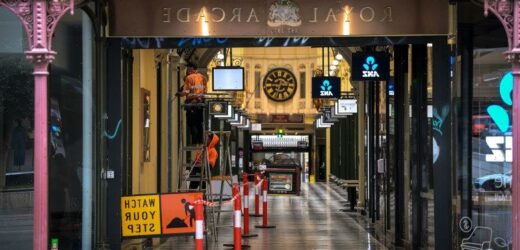For our free coronavirus pandemic coverage, learn more here.
It feels like forever. It’s been 200 days.
This week Melbourne clocks a double century of days spent in lockdown. That’s 39 per cent of our sleeping and waking lives battened down in our boxes since the end of March last year, when Premier Daniel Andrews first issued the order: “Stay home. Protect our health system. Save lives”.
“We are all going to have to sacrifice a lot,” he added. He wasn’t wrong.
Remember then? The good old days of “flatten the curve”? Mashd n Kutcher’s Get on the Beers? Gal Gadot murdering Imagine? The COVIDSafe app?
When lockdown felt like a novelty, a chance to catch up on great novels, learn new skills and emerge fitter, hotter and more learned?
When the chat was about sourdough starters and all being in it together and “we’ve got this”, rather than a revolving door of paranoia that we might not?
Of the 500-odd days that followed, we have spent 299 behind mandatory masks indoors, 100-plus at home (non-) schooling, 233 with closed church doors. We’ve lived through 93 wedding-less days, 56 curfewed nights and 178 days with playgrounds taped and silent.
We’re lost in a fog of numbers, clinging by our fingertips to passing digits to feel like we’re moving, that we’re making progress (or the opposite). And the lockdowns roll in, and roll out, and roll back in. We stumble in the fog over a number that we’d swear we stubbed our toes on a year ago, as a Bill Murray-less Groundhog Day of over-familiar conversations echoes around us.
This many lockdowns. That many cases. New cases, active cases, mystery cases, cases in the community, cases in quarantine. Numbers of doses, numbers of fully vaccinated, percentage of the population, percentage of the eligible population.
Timetables.
“Six weeks might feel like an eternity,” said Andrews, a line history has drenched in irony, as he announced the return of “stay at home” orders in July 2020 as the second wave surged up like a tsunami. “But it’s the time our health experts tell us they need to really get on top of this thing.”
There’s only one number more rubbery than a statistic: a prediction. Six weeks later, not even halfway through 2020’s big winter lockdown, the curfew hammer had just come down on our little five-kilometre bubbles.
To be fair, his crystal ball was a little clearer on July 4, 2020: “There will be no vaccine in the weeks ahead, some argue even in the months ahead.”
And the numbers are up for debate, always. Take even this 200-day lockdown milestone – defined as days when stay at home orders are in place. Some placed it on Wednesday, some Thursday and some Friday.
If you really want to know when to crack open the Bollinger, I put it at 8pm on Friday, except many lockdowns started at 11.59pm, so take off a few minutes from that, I guess?
Our 200 days at home is longer than the Battle of Britain, shorter than the Blitz. At the speed of light, it would get you an eighth of the way to the nearest star. At average walking speed, it would take about 200 days (without sleep) to pace the entire coastline of Australia.
Not that you would have been allowed to.
Numbers can help us make sense of it. If it feels like you’ve missed a lot – you have. It has been measured (exhaustively, by Maeve McGregor, The Age’s editorial intern). You’re not imagining it, it has been a lot of not.
A lot of Melbourne not being Melbourne. The unappreciated, depreciating cultural capital. Art galleries became empty mausoleums of dust-covered creativity, museums became warehouses of old stuff quietly getting older, for 233 days and counting.
So far, it has meant 257 days of cinemas, theatres, music halls and concert halls closed, ghost lights shining on stages. And that doesn’t include the capacity-capped weeks that crippled or cancelled shows large and small. That’s a long time without much entertainment, intrigue, inspiration or provocation. Live music is fine on the radio, or its digital equivalent, but it’s hard to raise a sweat over it. Or make a living.
We’ve gone 229 days without the zoo, that lifeline of child distraction, where one may gaze enviously at a small mustachioed monkey and imagine he’s been wondering why things have been so quiet recently, why those other big monkeys stopped visiting.
How about 118 days without hairdressing, as an epidemic of bowl cuts, mullets and amateur fringe-hackery spread across Melbourne, to the amusement of future generations. When they make films about the pandemic, actors will win sympathy-Oscars for getting the hair right.
Weeks and weeks of lost school, as parents convince themselves that maybe Minecraft is educational.
We’re at 243 days of takeaway only, that lukewarm reminder of a fine meal, and 173 days without pubs.
It’s almost a full year (344 days) of capacity-capped funeral numbers, of virtual, digitally streamed farewells that were crushing in the amplification of absence. Of friends and families feeling like they’ve betrayed the loved and lost, who feel an ache in the arm they wanted to put around the bereaved.
Ninety-three days of no weddings, 242 days of little ones. The best day of someone’s life, glimpsed through a camera held by someone who doesn’t know to put it into goddamned landscape mode, whose mic blurs the vows into incomprehensibility but accurately passes on the mutterings of a random nearby guest. Zoom weddings where the people you wanted to hear from forgot to unmute, and the people you definitely didn’t talked over everything.
Credit:Matt Golding
Milestones missed, replaced by milestones of numbers, ticking on and up.
The Romans came up with milestones: marble or granite pillars telling armies they had marched another 1000 paces to war, or home.
Scholars suspect they had a political role, too. Like the signs that pop up on modern infrastructure projects, they credited this emperor or that governor for the construction or repair of the route. There seems to be a correlation between milestone-laying and prolonged political instability: they became expressions of loyalty, evenly spaced billboards of propaganda.
So what do these milestones tell us? What do we carve on them for the ages?
What do we carve on anything? Our names. And we march on.
The Morning Edition newsletter is our guide to the day’s most important and interesting stories, analysis and insights. Sign up here.
Most Viewed in Politics
From our partners
Source: Read Full Article



